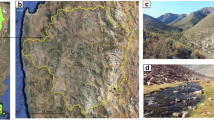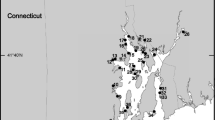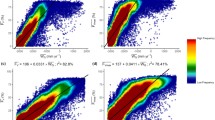Abstract
We analyzed trends in time series of the normalized difference vegetation index (NDVI) from multitemporal satellite imagery for 2001–2010 over the southeastern Everglades where major changes in vegetation structure and type have been associated with sea-level rise and reduced freshwater flow since the 1940s. Non-parametric trend analysis using the Theil-Sen slope revealed that 84.4 % of statistically significant trends in NDVI were negative, mainly concentrated in scrub mangrove, sawgrass (Cladium jamaicense) and spike rush (Eleocharis cellulosa) communities within 5 km of the shoreline. Observed trends were consistent with trends in sawgrass biomass measurements made from 1999 to 2010 in three Long-term Ecological Research (LTER) sites within our study area. A map of significant trends overlaid on a RapidEye high-resolution satellite image showed large patches of negative trends parallel to the shoreline in and around the “white zone,” which corresponds to a low-productivity band that has moved inland over the past 70 years. Significantly positive trends were observed mainly in the halophytic prairie community where highly salt tolerant species are typically found. Taken as a whole, the results suggest that increased saline intrusion associated with sea-level rise continues to reduce the photosynthetic biomass within freshwater and oligohaline marsh communities of the southeastern Everglades.







Similar content being viewed by others
References
An N, Price KP, Blair JM (2013) Estimating above-ground net primary productivity of the tallgrass prairie ecosystem of the Central Great Plains using AVHRR NDVI. International Journal of Remote Sensing 34:3717–3735
Armentano TV, Doren RF, Platt WJ, Mullins T (1995) Effects of Hurricane Andrew on coastal and interior forests of southern Florida: overview and synthesis. Journal of Coastal Research Special Issue 2:111–114
Armentano TV, Sah JP, Ross MS, Jones DT, Cooley HC, Smith CS (2006) Rapid responses of vegetation to hydrological changes in Taylor Slough, Everglades National Park, Florida, USA. Hydrobiologia 569:293–309
Baldwin AH, Mendelssohn IA (1998) Effects of salinity and water level on coastal marshes: an experimental test of disturbance as a catalyst for vegetation change. Aquatic Botany 61:255–268
Barlow PM, Reichard EG (2010) Saltwater intrusion in coastal regions of North America. Hydrogeology Journal 18:247–260
Barr JG, Fuentes JD, Engel V, Zieman JC (2009) Physiological responses of red mangroves to the climate in the Florida Everglades. Journal of Geophysical Research 114, G02008. doi:10.1029/2008JG000843
Barr JG, Engel V, Fuentes, Fuller DO, Kwon H (2013) Modeling light use efficiency in a subtropical mangrove forest equipped with CO2 eddy covariance. Biogeosciences 10:2145–2158
Barendregt A, Swarth CW (2013) Tidal freshwater wetlands: variation and changes. Estuaries and Coasts 36:445–456
Childers DL, Doren RF, Jones R, Noe GB, Rugge M, Scinto LJ (2003) Decadal change in vegetation and soil phosphorous patterns across the Everglades landscape. Journal of Environmental Quality 32:344–362
Childers DL, Iwaniec D, Rondeau D, Rubio G, Verdon E, Madden CJ (2006) Responses of sawgrass and spikerush to variation in hydrologic drivers and salinity in Southern Everglades marshes. Hydrobiologia 569:273–292
Couvillion BR, Beck H (2013) Marsh collapse thresholds for Coastal Louisiana estimated using elevation and vegetation index data. Journal of Coastal Research 63:58–67
Craighead FC (1968) The role of the alligator in shaping plant communities and maintaining wildlife in the southern Everglades. Florida Naturalist 41:2–7
Davis SE III, Childers DL, Day JW Jr, Rudnick DT, Sklar FH (2001) Nutrient dynamics in vegetation and unvegetated areas of a southern Everglades mangrove creek. Estuarine Coastal Shelf Science 52:753–768
Davis SM, Childers DL, Lorenz JJ, Wanless HR, Hopkins TE (2005) A conceptual model of ecological interactions in the mangrove estuaries of the Florida Everglades. Wetlands 25:832–842
De Jong R, de Bruin S, de Wit A, Schaepman ME, Dent DL (2011) Analysis of monotonic greening and browning trends from global NDVI time series. Remote Sensing of Environment 115:602–702
De Jong R, Verbesselt J, Zeileis A, Schaepman ME (2013) Shifts in global vegetation activity trends. Remote Sensing 5:1117–1133
Eastman RE (2012) IDRISI 17: The Selva edition. Clark Labs, Clark University, Worcester
Egler FE (1952) Southeast saline Everglades vegetation, Florida, and its management. Vegetatio 3:213–265
Ewe SML, Gaiser EE, Childers DL, Iwaniec D, Rivera-Monroy VH, Twilley RR (2006) Spatial and temporal patterns of aboveground net primary productivity along two freshwater-estuarine transects I the Florida Coastal Everglades. Hydrobiologia 569:459–474
Foti R, del Jesus M, Rinaldo A, Rodriguez-Iturbe I (2013) Signs of critical transition in the Everglades wetlands in response to climate and anthropogenic changes. Proceedings of the National Academy of Sciences—USA 110:6296–6300
Fuller DO (1998) Trends in NDVI time series and their relation to rangeland and crop production in Senegal, 1987–1993. International Journal of Remote Sensing 19:2013–2018
Goetz SJ, Prince SD, Goward SN, Thawley MM, Small J (1999) Satellite remote sensing of primary production: an improved production efficiency modeling approach. Ecological Modeling 122:239–255
Green EP, Mumby PJ, Edwards AJ, Clark CD, Ellis AC (1997) Estimating leaf area index of mangroves from satellite data. Aquatic Botany 58:11–19
Greenberg R, Maldonado J, Droege S, McDonald MV (2006) Tidal marshes: a global perspective on the evolution and conservation of their terrestrial vertebrates. BioScience 56:675–685
Hassaan MA, Abdrabo MA (2013) Vulnerability of the Nile Delta coastal areas to inundation by sea level rise. Environmental Monitoring and Assessment 185:6607–6616
Herrmann SM, Anyamba A, Tucker CJ (2005) Recent trends in vegetation dynamics in the African Sahel and their relationship to climate. Global Environmental Change-Human and Policy Dimensions 15:394–404
Jiang Z, Huete AR, Didan K, Miura T (2008) Development of a two-band enhanced vegetation index without a blue band. Remote Sensing of Environment 112:3833–3845
Justice CO, Townshend JRG (1988) Selecting the spatial resolution of satellite sensors required for global monitoring of land transformations. International Journal of Remote Sensing 9:187–236
Loucks C, Barber-Meyer S, Hossain MAA, Barlow A, Chowdhury RM (2010) Sea level rise and tigers: predicted impacts to Bangladesh’s Sundarbans mangroves. Climatic Change 98:291–298
Macek P, Rejmánková E (2007) Response of emergent macrophytes to experimental nutrients and salinity additions. Functional Ecology 21:478–488
Myneni RB, Dong C, Tucker CJ, Kaufmann RK, Kauppi PE, Liski J, Zhou L, Alexeyev V, Hughes MK (2001) A large carbon sink in the woody biomass of northern forests. Proceedings of the National Academy of Sciences—USA 98:14784–14789
Neeti N, Eastman JR (2011) A contextual Mann-Kendall approach for the assessment of trend significance in image time series. Transactions in GIS 15:599–611
Neubauer SC (2008) Contributions of mineral and organic components to tidal freshwater marsh accretion. Estuarine, Coastal and Shelf Science 78:78–88
Neubauer SC (2013) Ecosystem responses of a tidal freshwater marsh experiencing saltwater intrusion and altered hydrology. Estuaries and Coasts 36:491–507
Paruelo JM, Epstein HE, Lauenroth WK, Burke IC (1997) ANPP estimates from NDVI for the Central Grassland region of the United States. Ecology 78:953–958
Pineiro G, Oesterheld M, Paruelo JM (2006) Seasonal variation in aboveground production and radiation-use efficiency of temperate rangelands estimated through remote sensing. Ecosystems 9:357–373
Ross MS, Meeder JF, Sah JP, Ruiz PL, Teesnicki GJ (2000) The southeast saline Everglades revisited: 50 years of coastal vegetation change. Journal of Vegetation Science 11:101–112
Ross MS, Gaiser EE, Meeder JF, Lewin MT (2002) Multi-taxon analysis of the “white zone”: A common ecotonal feature of the South Florida coastal wetlands. In: Porter JW, Porter KG (eds) The Everglades, Florida Bay, and Coral Reefs of the Florida Keys: An ecosystem sourcebook. CRC Press, Boca Raton
Sen PK (1968) Estimates of the regression coefficient based on Kendall’s tau. Journal of the American Statistical Association 63:1379–1389
Spalding M, Kainuma M, Collins L (2010) World Atlas of mangroves. Earthcan, London, 319 pp
Sternberg LSL, Teh SY, Ewe SML, Miralles-Wilhelm F, DeAngelis DL (2007) Competition between hardwood hammocks and mangroves. Ecosystems 10:648–660
Theil H (1950) A rank-invariant method of linear and polynomial regression analysis I, II and III. In Proceedings of the Section Sciences, Koninklijke Academie van Wetenschappen te, Amsterdam, Netherlands, pp. 386–392
Van Lent T, Johnson R, Fennema R (1993) Water management in the Taylor Slough and effects on Florida Bay. Technical Report #SFNRC 93-03. South Florida Natural Resource Center, Everglades National park, Homestead, Florida, USA
Wang H, Wright TJ, Yu Y, Lin H, Jiang L, Li C, Qui G (2012) InSAR reveals coastal subsidence in the Pearl River Delta, China. Geophysical Journal International 191:1119–1128
Wanless HR, Parkinson RW, Tedesco LP (1994) Sea level control on stability of Everglades wetlands. In: Davis SM, Ogden JC (eds) Everglades: The ecosystem and its restoration. St. Lucie Press, Delray Beach, pp 199–223
Wanless HR, Vlaswinkel B (2005) Coastal landscape and channel evolution affective critical habitats at Cape Sable, Everglades National Park, Florida. Final report to Everglades National Park. United States Department of the Interior, Homestead
Webb EL, Friess DA, Krauss KW, Cahoon DR, Guntenspergen GR, Phelps J (2013) A global standard for monitoring coastal wetland vulnerability to accelerated sea-level rise. Nature Climate Change 3:458–464
Welch R, Madden M, Doren RF (1999) Mapping the Everglades. Photogrammetric Engineering and Remote Sensing 65:163–170
Wessels KJ, Prince SD, Reshef I (2008) Mapping land degradation by comparison of vegetation production to spatially derived estimates of potential production. Journal of Arid Environments 72:1940–1949
Acknowledgments
The authors wish to thank Raymond Turner of Center for Southeast Tropical Advanced Remote Sensing (CSTARS) for providing the RapidEye image. We are grateful to the many scientists of the FCE LTER who have made their field data publicly available. Support for this research was provided by NASA WaterSCAPES (Science of Coupled Aquatic Processes in Ecosystems from Space) Grant NNX08BA43A.
Author information
Authors and Affiliations
Corresponding author
Rights and permissions
About this article
Cite this article
Fuller, D.O., Wang, Y. Recent Trends in Satellite Vegetation Index Observations Indicate Decreasing Vegetation Biomass in the Southeastern Saline Everglades Wetlands. Wetlands 34, 67–77 (2014). https://doi.org/10.1007/s13157-013-0483-0
Received:
Accepted:
Published:
Issue Date:
DOI: https://doi.org/10.1007/s13157-013-0483-0




